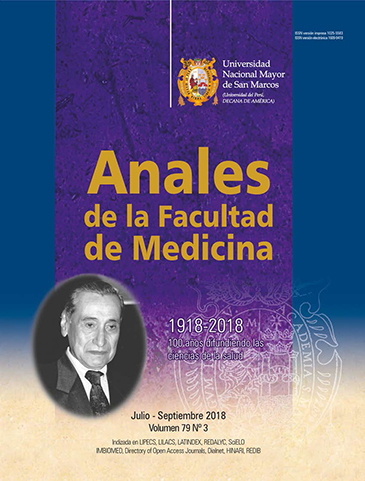Obesity, insulin resistance and type 2 diabetes mellitus in adolescents
DOI:
https://doi.org/10.15381/anales.v79i3.15311Keywords:
Obesity, Insulin resistance, Diabetes mellitus, Adolescent, DyslipemiasAbstract
Introduction. Obesity is considered a public health problem. Its presence at an early age implies an obligation to identify the onset of complications such as insulin resistance and diabetes mellitus (DM). Methods. Observational, descriptive and transversal study. Participated 1206 teenage women. Obesity was defined with BMI values ≥95p according WHO. Serum levels of insulin, glucose and lipid profile were determined. T≥≤h e43 0,H1 m6o mgto/ed odLse,t fahinsigiesh i MnCso-uLdlDeinlL o r≥ef sA 1iss3tsa0en smcmege (/n Rdt IIL)n. daFneodxr (hdHyyOpsleMiptrAiidg-eIl)ym cwieaarssid: uehsmyepidae, r≥ucsh 1ion3lge0 s tmhteegr o/MdleaLmt.t hTiaeh we≥ so 2be0qe0su eam ttigeo/endn wLa,ig tlheo rwtsh ewH viDtahLl u-RCeI underwent an oral glucose tolerance test (PTG): glycemia of 140 to 199 mg / dL intolerant to glucose and ≥ 200 mg/dL as diabetic. Results 25,1% (303) of the population was obese; 246 obese adolescents participated in the biochemical evaluation, 28,1% (69) of them presented RI. In the obese teenagers with and without IR, the average of the biochemical variables in the former were higher, these differences being statistically significant, except for HDL-C. Differences between the prevalence of dyslipidemias were significant except for HDL-C. The IR presented an OR of 10,9 (CI 5,4-26,6), 12,1 (CI 4,9-30,1), and 7,6 (CI 3-19,5) with hypertriglyceridemia, hypercholesterolemia and high LDL-C. The PTG showed 3,3% intolerant and none diabetic. Conclusions: 28,1% (69) of obese adolescents presented RI; no study participant presented DM.Downloads
Published
2018-10-08
Issue
Section
Artículo Original
License
Copyright (c) 2018 Anales de la Facultad de Medicina

This work is licensed under a Creative Commons Attribution-NonCommercial-ShareAlike 4.0 International License.
Those authors who have publications with this magazine accept the following terms:
- Authors will retain their copyrights and guarantee the journal the right of first publication of their work, which will be simultaneously subject to Creative Commons Attribution License that allows third parties to share the work as long as its author and its first publication this magazine are indicated.
- Authors may adopt other non-exclusive licensing agreements for the distribution of the version of the published work (eg, deposit it in an institutional electronic file or publish it in a monographic volume) provided that the initial publication in this magazine is indicated.
- Authors are allowed and recommended to disseminate their work over the Internet (eg: in institutional telematic archives or on their website) before and during the submission process, which It can produce interesting exchanges and increase quotes from the published work. (See El efecto del acceso abierto ).
How to Cite
1.
Pajuelo Ramírez J, Bernui Leo I, Sánchez González J, Arbañil Huamán H, Miranda Cuadros M, Cochachin Henostroza O, et al. Obesity, insulin resistance and type 2 diabetes mellitus in adolescents. An Fac med [Internet]. 2018 Oct. 8 [cited 2025 Jun. 7];79(3):200-5. Available from: https://revistasinvestigacion.unmsm.edu.pe/index.php/anales/article/view/15311



